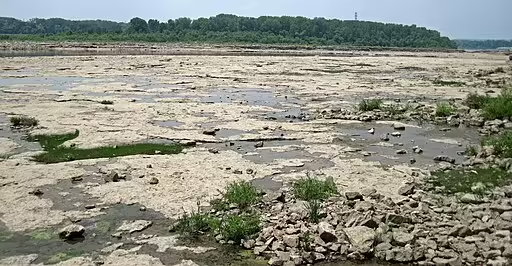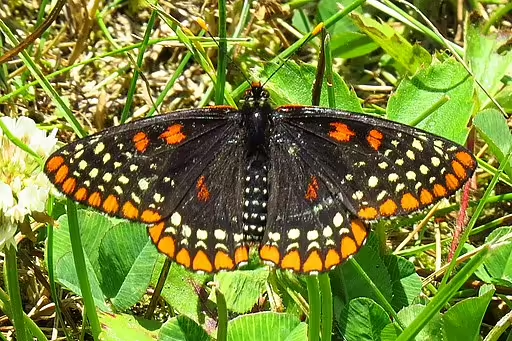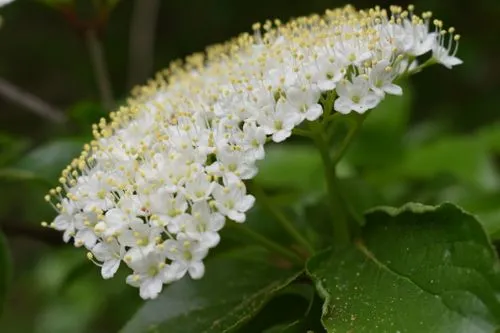Table of Contents for Hairy Goldenrod (Solidago hispida)
Hairy Goldenrod (Solidago hispida) is a herbaceous perennial that is native to the mid-western and eastern United States. This species is a host to the baltimore checkerspot (Euphydryas phaeton) and several moths. Growing from 1 foot to 3 feet tall, this species grows in wooded areas that are shaded and thickets. The yellow flowers bloom from July to September and the plant is hardy in zones 3-8.
Taxonomy and Naming of Hairy Goldenrod (Solidago hispida)

Taxonomy
Hairy Goldenrod (Solidago hispida) was originally named and described by Gotthilf Heinrich Ernst Muhlenberg, an American botanist, in 1803. However it was invalidly published and was republished by Carl Ludwig Willdenow, a German botanist. It has kept this same name since and is a member of the Aster Family (Asteraceae).
Meaning of the Scientific and Common Names
Scientific Name
The genus name, Solidago, derives from the Latin words, Solidus and ago, which together mean to make (ago) whole (Solidus). This meaning comes from the medicinal uses of the plant. The species name, hispida, is Latin for hairy.
Common Name and Alternative Names
The common name comes from the hairy stem of the species. Some other common names include rough goldenrod (Judziewicz 1997) and shaggy goldenrod (Harms 1994).
Physical Description

- Plant Type: This plant is a herbaceous perennial.
- Height: 1 ft (0.3 m) to 3 ft (0.9 m)
- Stem: The stems are erect and pubescent (Flora of North America).
- Leaves: The leaves are alternate, with basal rosettes and cauline leaves, ovate or winged-shaped, petioles are winged, and serrate margins. They are 2 in (5 cm) to 7 in (18 cm) long and 1 in (1 cm) to 4 in (10.1 cm) wide.
- Flower color: yellow
- Blooming period: This plant blooms from July to October.
- Fruiting type and period: This plant has achenes that mature in the late fall and winter.
Range of Hairy Goldenrod in the United States and Canada

This goldenrod species is native to the mid-western and eastern United States and Canada. It is considered to be rare in the states of Delaware, Maryland, New Jersey, North Carolina, South Carolina, Virginia, and the province of Newfoundland and Labrador.
Habitat

This species grows in open areas such as fields and meadows and open woods (Flora of North America), cliffs and shoreline rocks (Butters and Abbe 1953), thickets and sand hills (Porsild 1941), sand barrens (Carbyn and Catling 1995), serpentine soils (Bouchard et al 1978 and Kruckeberg and Reeves 1995), limestone scree slopes (Argus 1964), dry, rocky woods (Stetson 1913), and mixed mesophytic forest (Klugh 1913).
Hosted Insects

This goldenrod, like a lot of other goldenrods, is a host to wavy-lined emerald (Synchlora aerata). The genus in general is a host to the Baltimore Checkerspot (Euphydryas phaeton) and black swallowtail (Papilio polyxenes).
Other Supported Wildlife

This species is a nectar source to other butterflies, skippers, bees, and wasps during the growing season. It is especially important since it provides a nectar source in the late season. The yellow-banded bumble bee (Bombus terricola) (Colla and Dumesh 2010).
Frequently Asked Questions
Does this plant have any ethnobotanical uses?
The Native American Ethobotanical Database does not describe this species specifically, but the genus in general has been used as a nasal and stomach remedy.
How is this plant distinguished from other Goldenrods?
This goldenrod is similar to the wreath goldenrod (Solidago caesia) and Curtis’ goldenrod (Solidago curtisii) but these species have a glabrous stem, while this species has a pubescent stem (Taylor and Taylor 1983).
Is this plant invasive?
This has not been noted as being weedy.
Gardening with Hairy Goldenrod

Hardiness
This species is hardy in zones 3-8. If your garden is within these zones and you have the right growing conditions (soil, moisture and exposure), you may well be able to grow this plant. However, if planted outside of its range, the hosted species may not recognize the plant or be harmed by ingesting a different species with an unfamiliar chemical composition.
Optimal Conditions
This species enjoys full sun to part-shade in medium to dry well-drained soils. In general, given the natural substrate, soils should be circumneutral or higher.
References
- Argus, George W. 1964. Plant Collections from Carswell Lake and Beartooth Island, Northwestern Saskatchewan, Canada. The Canadian Field-Naturalist 78(3): 139-149.
- Bouchard, Andre’, Stuart Hay, Ernest Rouleau. 1978. The Vascular Flora of St. Barbe South District, Newfoundland: An Interpretation Based on Biophysiographic Areas. Rhodora 80: 228-308.
- Butters, F.K. and Ernst C. Abbe. 1953. A Floristic Study of Cook County, Northeastern Minnesota. Rhodora 55: 161-201.
- Carbyn, Susan and Paul M. Catling. 1995. Vascular flora of sand barrens in the middle Ottawa Valley. The Canadian Field-Naturalist 109(2): 242-250.
- Colla, S.R. and S. Dumesh. 2010. The Bumble Bees of Southern Ontario: Notes on Natural History and Distribution. Journal of the Entomological Society of Ontario 141: 39-50.
- Harms, Vernon L. 1994. Flora of the Besnard Lake Area, North-Central Saskatchwan. Blue Jay 52(4): 190-199.
- Judziewicz, Emmet J. 1997. Vegetation and Flora of Passage Island, Isle Royale National Park, Michigan. 36: 35-62.
- Klugh, A.B. 1913. Notes on the Plant Formations of the Shores of Georgian Bay. The Ontario Natural Science Bulletin 8: 13-31.
- Krukeberg, A.R. and R.D. Reeves. 1995. Nickel Accumulation by Serpentine Species of Strepthanthus (Brassicaceae): Field and Greenhouse Studies. Madrono 42(4): 458-469.
- Porsild, A.E. 1941. A Relic Flora on Sand Dunes From the Champlain Sea in the Ottawa Valley. The Canadian Field-Naturalist 55(5): 66-72.
- Stetson, Sereno. 1913. The Flora of Copake Falls, NY. Torreya 13(6): 121-133.
- Taylor, Constance E.S. and R. John Taylor. 1983. New Species, New Combinations and Notes on the Goldenrods (Euthamia and Solidago – Asteraceae). Sida 10(2): 176-183.


